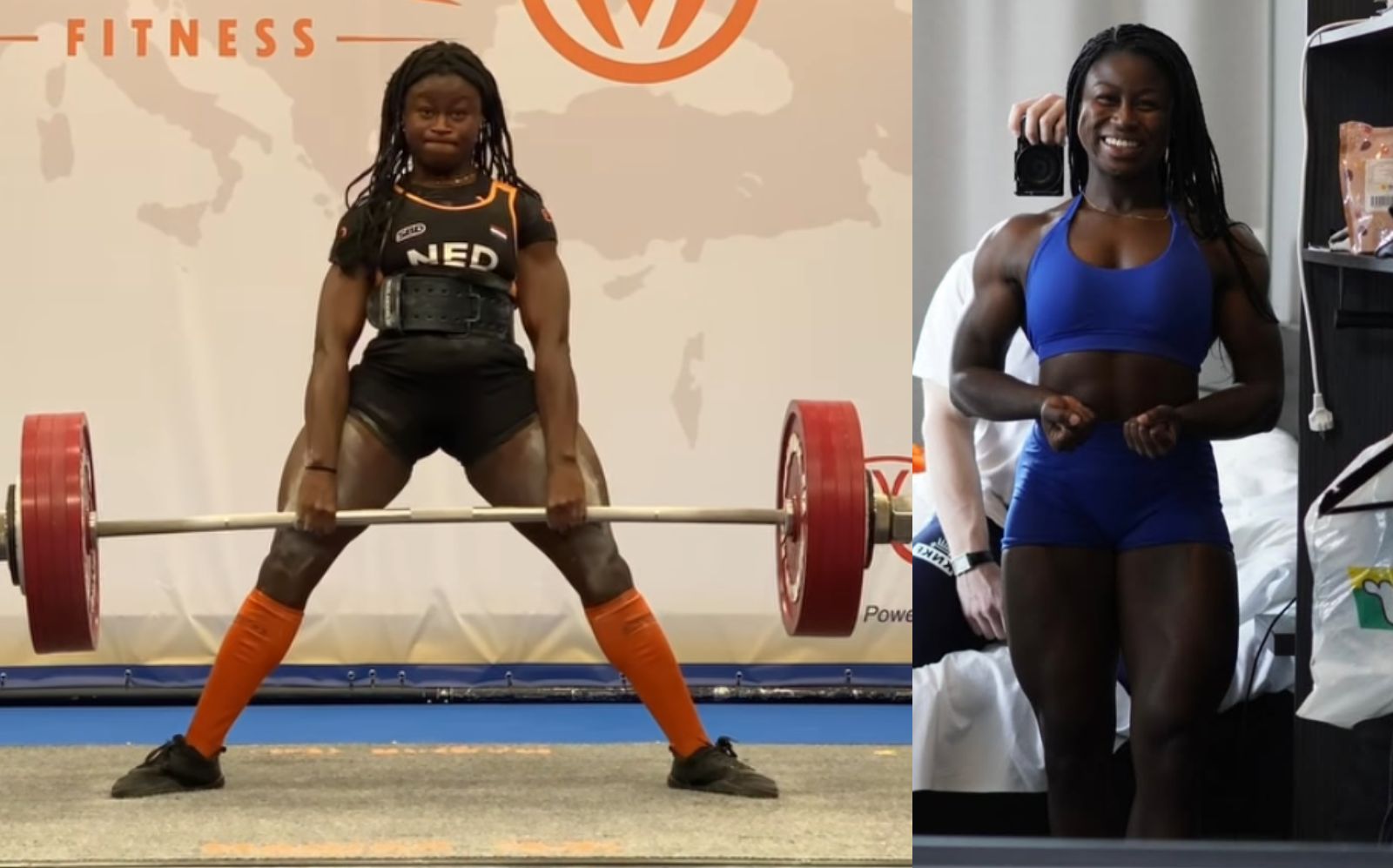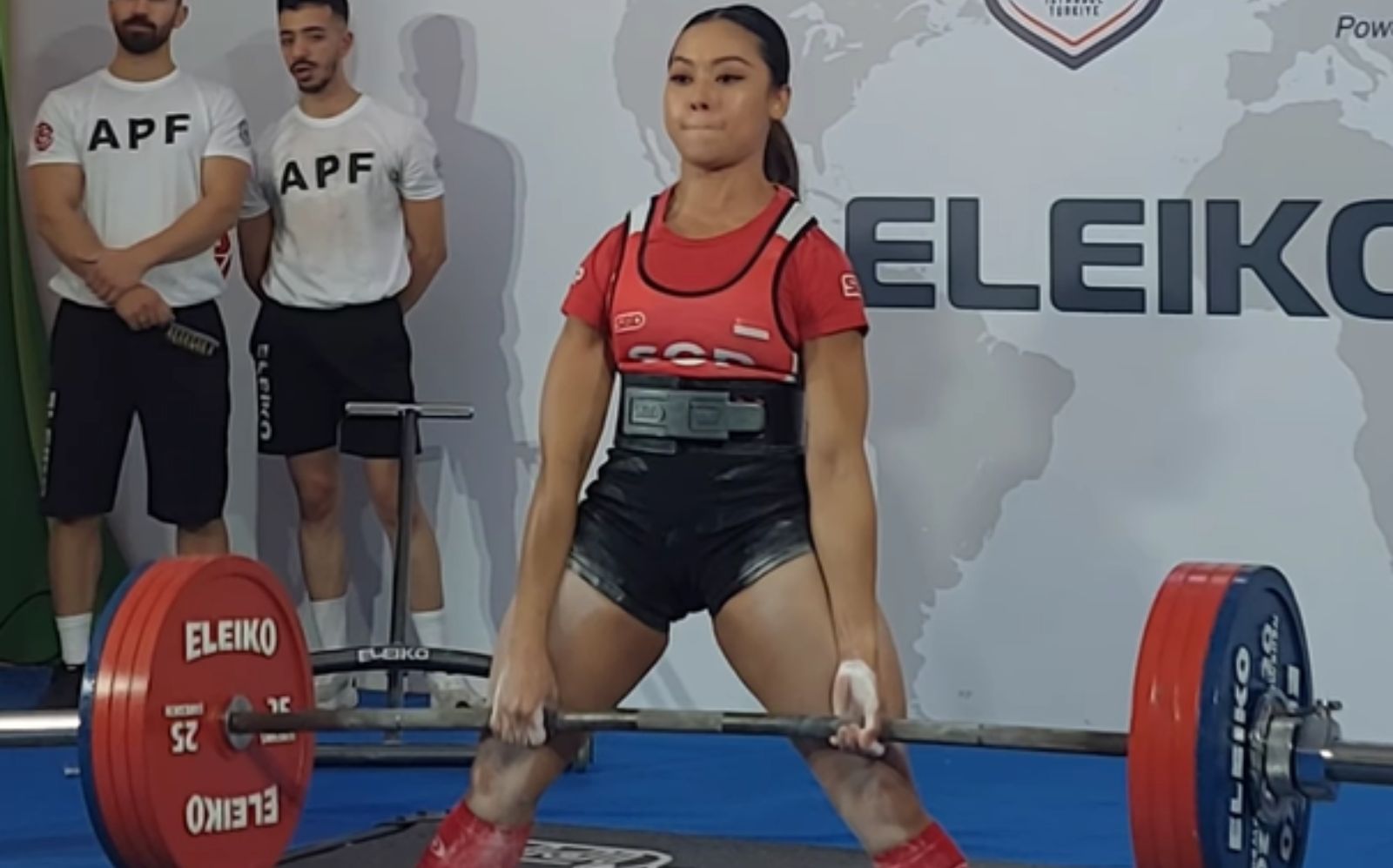The deadlift is one of the best strength and muscle-building exercises around. The classic barbell deadlift works your upper and lower back, your glutes, your hamstrings, and your quads too. Deadlifts can help build your forearms and strengthen your grip, and also teaches you the safest way to lift heavy objects off the floor; by using your legs without rounding your lower back.
While there is no denying the proven benefits of the deadlift, that doesn’t mean this exercise is compulsory. Past injuries, being really tall and long-legged, or not having access to a barbell and weight plates can mean this exercise is not practical or possible.
Don’t worry, though. There are plenty of deadlift alternatives you can do instead. The following exercises are all excellent replacements for regular barbell deadlifts that work the same muscles.
1- Trap bar deadlift
A trap bar is a hexagonal frame that you stand inside. This positions the weight in line with the feet. With conventional barbell deadlifts, the weight is in front of you. Placing the weight next to your feet takes a lot of strain off your lower back. If back pain means you can’t do regular deadlifts, this could be a good alternative. However, you will probably feel this exercise more in your quads than your glutes and hamstrings, as you would when doing regular deadlifts.
How to do trap bar deadlift:
- Load your bar and place it on the floor. Use large diameter plates, such as 45lbs. to raise the bar to mid-shin height. Alternatively, set the bar on boxes or stacked weight plates.
- Stand inside the bar with your feet between hip and shoulder-width apart.
- Squat down and hold the handles with a firm grip. Drop your hips, lift your chest, and brace your abs tight. Do not round your lower back.
- Keeping your arms straight, drive your feet into the floor, and stand up. Do not lean back at the top of the movement.
- Bend your legs, lower the weight back to the floor, and repeat.
Exercise tips:
- Start with lighter weights that’ll allow you to do at least 10 reps and build up your working weight if you’re a beginner.
- If your lower back is rounding excessively, lighten the load and/or fix your posture.
- Use your legs to lift the weight from the floor and not your back.
No trap bar? No problem! Do this exercise with a dumbbell in each hand instead.
Level Up Your Fitness: Join our 💪 strong community in Fitness Volt Newsletter. Get daily inspiration, expert-backed workouts, nutrition tips, the latest in strength sports, and the support you need to reach your goals. Subscribe for free!
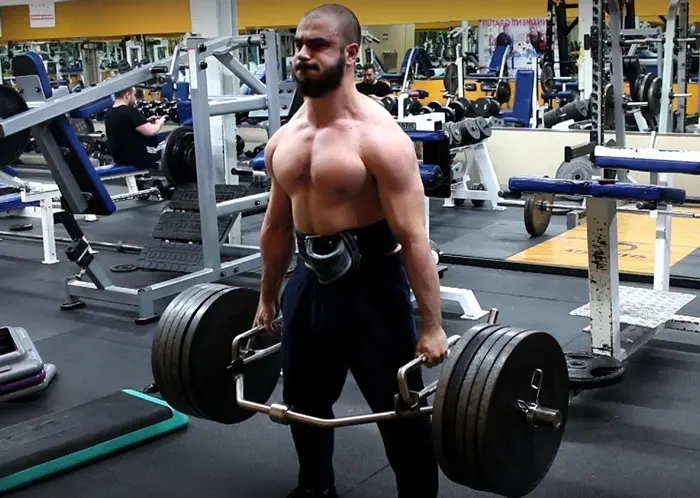
2- Kettlebell swings
Of all the exercises you can do with a kettlebell, swings are the best deadlift alternative. They work the same muscles but in a much more explosive way. This will develop muscle power as well as strength. High-rep kettlebell swings are also a very useful cardio and fat-burning exercise. You can also do this exercise with a single dumbbell.
How to do kettlebell swings:
- Hold the weight in front of your hips and stand with your feet shoulder-width apart. Bend your knees slightly.
- Push your hips back and lean your torso forward. Do not round your back. Lower the weight between your knees.
- Drive your hips forward and quickly stand up. Swing the weight forward and up to around shoulder-height.
- Swing the kettlebell back down between your legs and repeat. Do not round your lower back.
Exercise tip/s:
Some people do this exercise by swinging the weight above their heads. CrossFitters call this the American swing. You can do this if you wish, but doing so puts more strain on your lower back. If you have any kind of back pain, only raise the weight to shoulder-height.
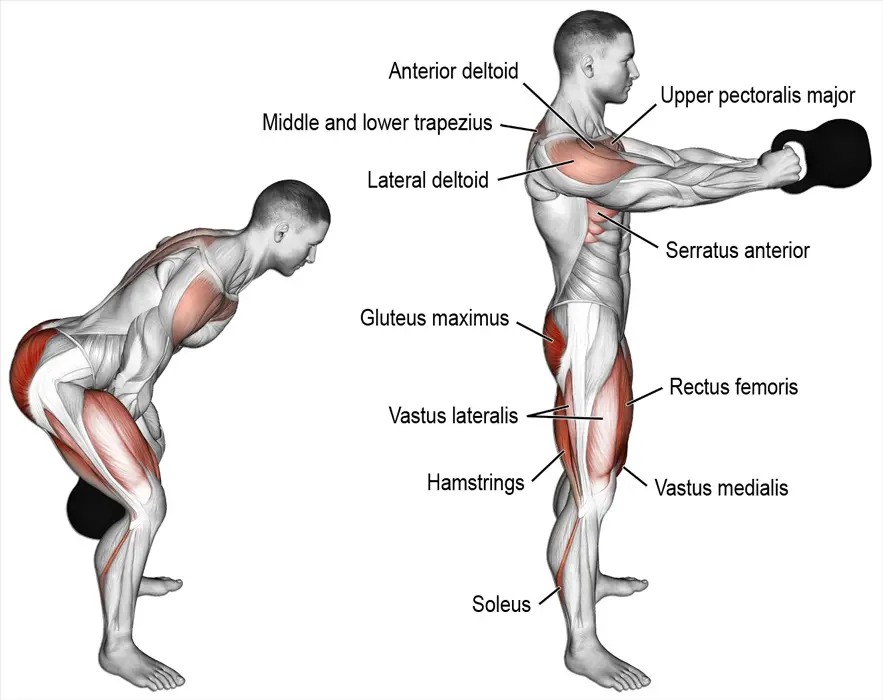
3- Single-leg Romanian deadlifts
Romanian deadlifts are not just a good deadlift alternative, but it’s also better for your balance and much easier on your lower back. Working one leg at a time means it’s a good way to fix any left-to-right leg strength imbalances you may have. Best of all, you can do this exercise with nothing more than a single dumbbell or kettlebell.
Level Up Your Fitness: Join our 💪 strong community in Fitness Volt Newsletter. Get daily inspiration, expert-backed workouts, nutrition tips, the latest in strength sports, and the support you need to reach your goals. Subscribe for free!
How to do it:
- Stand tall with your feet together. Shift your weight over onto one leg and bend the same knee slightly.
- Lean forward from your hips and extend your opposite leg out behind you for balance. Do not round your lower back.
- Lower whatever weight you are holding down to mid-shin level.
- Drive upward through your heel and midfoot to stand back up and repeat. Do the same number of reps on each leg.
Exercise tips:
- Beginners should start with light dumbbells that will allow you to perform reps in a 10-20 rep range.
- Stop the workout immediately if you feel lower back discomfort.
- Make sure your lower back does not round during this movement.
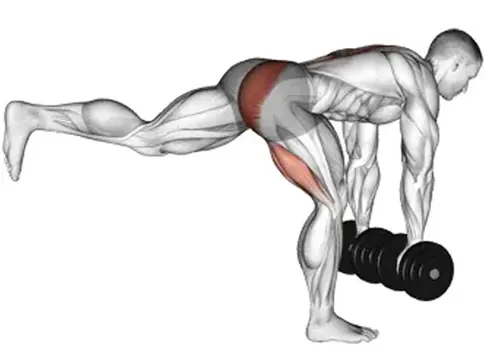
4- 45-degree back extensions
You don’t have to use weights as a deadlift alternative; bodyweight exercises can be just as effective. The 45-degree back extension works your lower back, glutes, and hamstrings in the same way as deadlifts but without lifting heavyweights.
How to do it:
- Adjust the height of the back extension machine so that the top of the pad is level with the uppermost part of your pelvis.
- Climb onto the machine and lean your hips against the pad. Keep your knees slightly bent throughout.
- Without rounding your lower back too much, lean forward and lower your head down below the level of your hips.
- Lift your body back up until your shoulders, hips, and feet form a straight line. Do not over-extend your spine.
Exercise tips:
- Make this exercise harder by holding a weight plate across your chest or dumbbells in your hands.
- Keep a neutral spine the best you can.
- Stop immediately if you feel lower back pain/discomfort.
5- Good mornings
The good-morning is a popular exercise with powerlifters. It’s an effective way to build your lower back, hamstrings, and glutes, but you don’t need to grip the barbell with your hands as you do during deadlifts. Use a lightweight at first; this is a challenging exercise.
How to do it:
- Rest and hold a barbell across your shoulders as though you were going to do squats. Stand with your feet between shoulder and hip-width apart. Bend your knees slightly and keep them rigid throughout.
- Without rounding your lower back, lean forward as far as your flexibility allows. Grip the bar tightly to stop it rolling up your neck.
- Stand back up and repeat.
Exercise tips:
- Start with the bar first and learn proper form before adding weight.
- If you have difficulty doing this exercise without rounding your back, stop the exercise and work on correcting your form. Some people may not be able to do this movement safely.
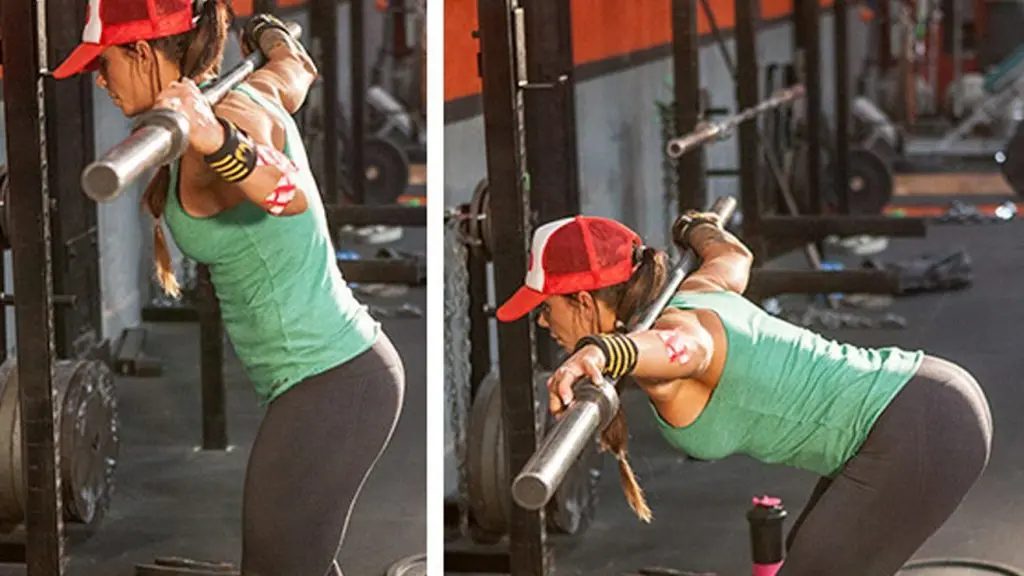
6- Hip thrusts
Hip thrusts work your glutes, hamstrings, and quads, but without putting much strain on your lower back. For a back-friendly deadlift alternative, this effective exercise is tough to beat. It’s also an excellent booty builder!
How to do hip thrusts:
- Sit on the floor with your legs bent, feet on the floor, and your back against a flat exercise bench. Weigh the bench down to stop it moving during your workout.
- Drive your feet down into the floor and lift your hips up until your thighs and body are roughly parallel to the floor.
- Lower your butt back down to the floor and repeat.
Exercise tips:
- Make this exercise more intense by resting and holding a barbell across your hips or using a resistance band. Some gyms also have specialized hip thrust benches.
- Don’t be afraid to load up the weight when you’re more advances as the hip thrust is an excellent mass and strength builder.
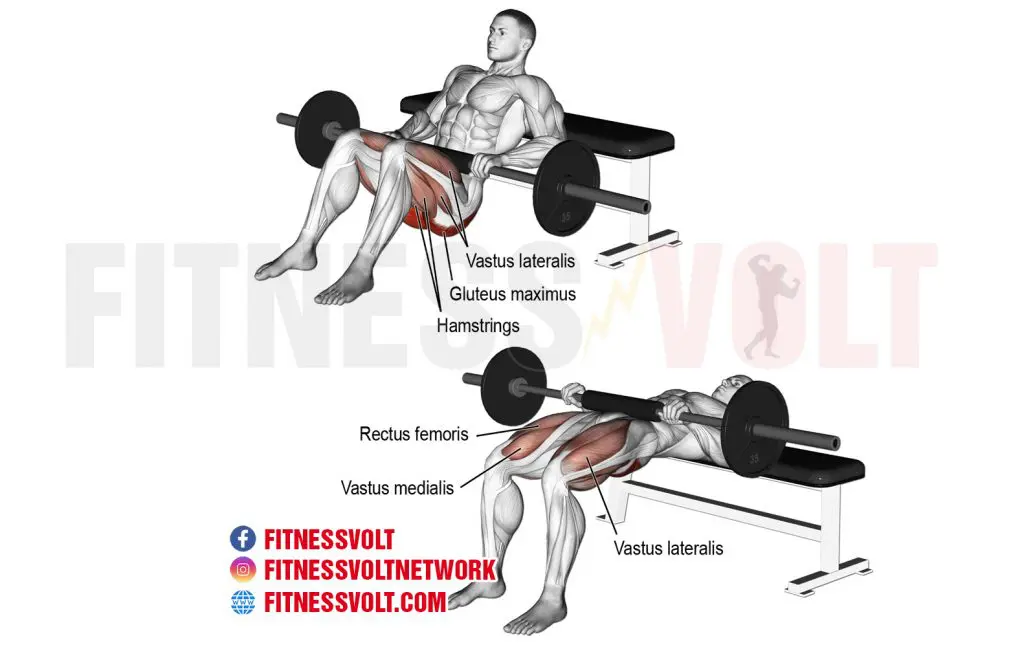
7- Cable pull-throughs
Cable pull-throughs are a lot like kettlebell swings, but you move more slowly. This helps keep your muscles under tension for longer, which, according to research, is a vital factor for hypertrophy or muscle growth (1).
How to do it:
- Attach a rope handle to a low pulley machine. Stand with the handle between your legs and your back to the pulley machine. Your feet should be about shoulder-width apart.
- Bend your knees slightly, push your hips back, and lean forward as far as you can without rounding your lower back. Let the handle and cable pass between your legs.
- Thrust your hips forward and stand up. Squeeze your glutes and hamstrings hard before doing another rep. This will help strengthen your mind-muscle connection, making this deadlift alternative exercise even more effective (2).
Exercise tip:
- Do not hyperextend your back at the top/standing portion of the exercise.
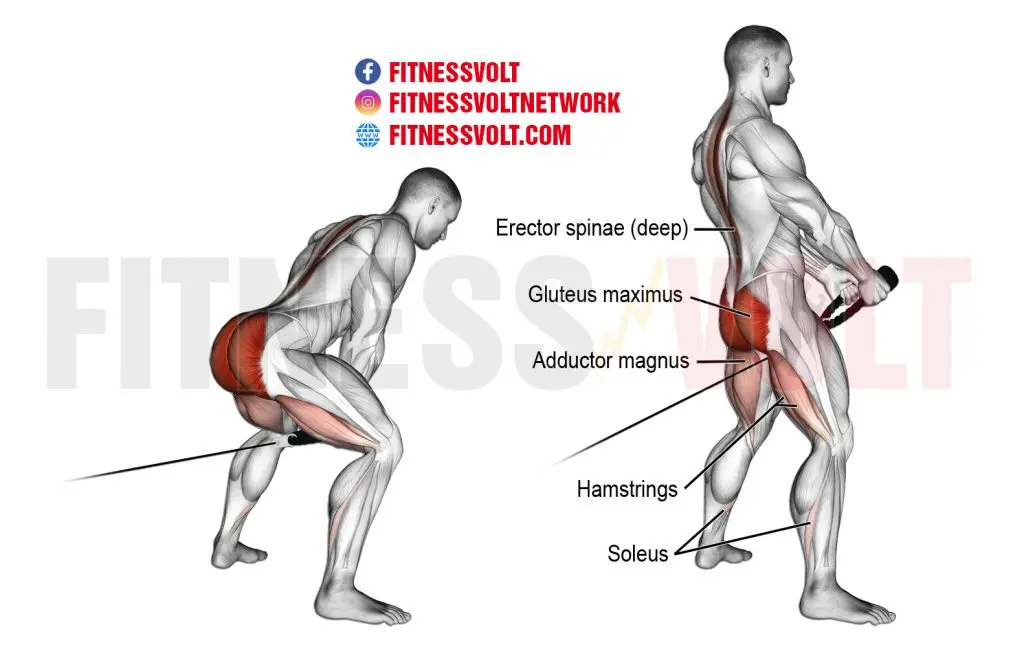
Frequently Asked Questions (FAQs)
What are some effective deadlift alternatives?
There are several very effective deadlift alternatives but we’ve listed 7 viable options which include…
- Trap bar deadlift
- Kettlebell swings
- Single-leg Romanian deadlift
- 45-degree back extensions
- Good mornings
- Hip thrusts
- Cable pull-throughs
Keep in mind, these exercises cannot replace a conventional deadlift for their strength benefits. But, these movements do target the same muscles in general.
What is the best deadlift alternative?
That’s a difficult question to answer because there are many different exercises that you can use as a deadlift alternative. However, the best deadlift alternative options for developing similar strength are ones that mimic the actual deadlift.
A few examples are the trap bar deadlift and Romanian deadlift.
Can I build the same amount of muscle and strength with deadlift alternatives?
Well, it depends. Deadlift alternatives that are isolation exercises (e.g. kettlebell swing) will not build close to the same amount of strength or even muscle mass.
But if you’re utilizing alternatives similar to the conventional deadlift that require full-body involvement, then you can build a similar amount of strength and mass.
Many alternatives won’t elicit the same results but they do activate many the same muscles, which is ideal for certain individuals.
Can deadlift alternatives help your conventional deadlift performance?
If the alternatives are similar in nature to the conventional deadlift then yes, they can contribute to overall deadlift strength. But you’d have to ensure you’re making similar strength gains by lifting very challenging poundages on a consistent basis.
Conclusion
There is no point in denying the power of the deadlift for building muscle mass and strength. But that doesn’t mean you have to include it in all your workouts. Some people just aren’t able to deadlift safely or don’t have the necessary space or equipment. Don’t let that hold you back; do any of these deadlift alternatives instead.
References:
- Goldberg, A. L.; Etlinger, J. D.; Goldspink, D. F.; Jablecki, C. (1975). “Mechanism of work-induced hypertrophy of skeletal muscle”. Medicine and Science in Sports. 7 (3): 185–198. ISSN 0025-7990. PMID 128681. https://www.ncbi.nlm.nih.gov/pubmed/128681
- Calatayud, Joaquin; Vinstrup, Jonas; Jakobsen, Markus Due; Sundstrup, Emil; Brandt, Mikkel; Jay, Kenneth; Colado, Juan Carlos; Andersen, Lars Louis (2016-03). “Importance of mind-muscle connection during progressive resistance training”. European Journal of Applied Physiology. 116 (3): 527–533. doi:10.1007/s00421-015-3305-7. ISSN 1439-6327. PMID 26700744. https://www.ncbi.nlm.nih.gov/pubmed/26700744





